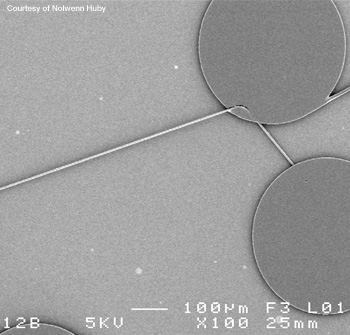
A pristine silk fiber integrated into a photonic chip. The fiber connects three disks that can hold light. During the experiment, light is injected into one of the disks and propagates along the silk to the other two.
Who knew that spider silk, long studied for its tensile strength, also acts like an optical fiber? French physicists are investigating the light-carrying properties of this all-natural material for on-chip integration with other photonic structures.
At this week’s Frontiers in Optics conference in Rochester, N.Y. (U.S.A.), Nolwenn Huby of the CNRS Institut de Physique de Rennes (France) described her group’s research into the optical properties of the silk fiber spun by Nephila clavipes, a colorful spider found in the warmer regions of North and South America. In nature, the female N. clavipes spins webs up to 1 m in diameter with silk six times as strong as steel.
First, Huby’s group tested the light propagation ability of the 5-µm-wide fibers, which have a refractive index of about 1.55, and found attenuation of 20 ± 10 dB/cm. Next, the researchers verified the optical coupling of two silk fibers separated by a 15-µm gap.
Finally, Huby and her team used the spider silk to connect three disk reservoirs etched by ultraviolet lithography onto a silicon-based substrate. When they sent a laser beam through these photonic structures, a microbeam profiler confirmed that they were properly coupled. The results, she said, hold great promise for future biophotonics applications.
In the same conference session, Fiorenzo Omenetto of Tufts University (U.S.A.) described similar research with a natural fiber found more often in the clothes closet than in the clean room: silk from silkworms. This material could be combined with other substances to make tiny biomedical implants.
In another session at Frontiers in Optics, OSA’s annual meeting, David Trolio and colleagues at the State University of New York College of Optometry (U.S.A.) discussed their specially designed contact lenses that may reduce the progression of myopia in children. Also, researchers from Ben Gurion University of the Negev (Israel) found that a simple green laser pointer could be the basis of a highly portable Raman spectrometer for detecting traces of hazardous substances.
